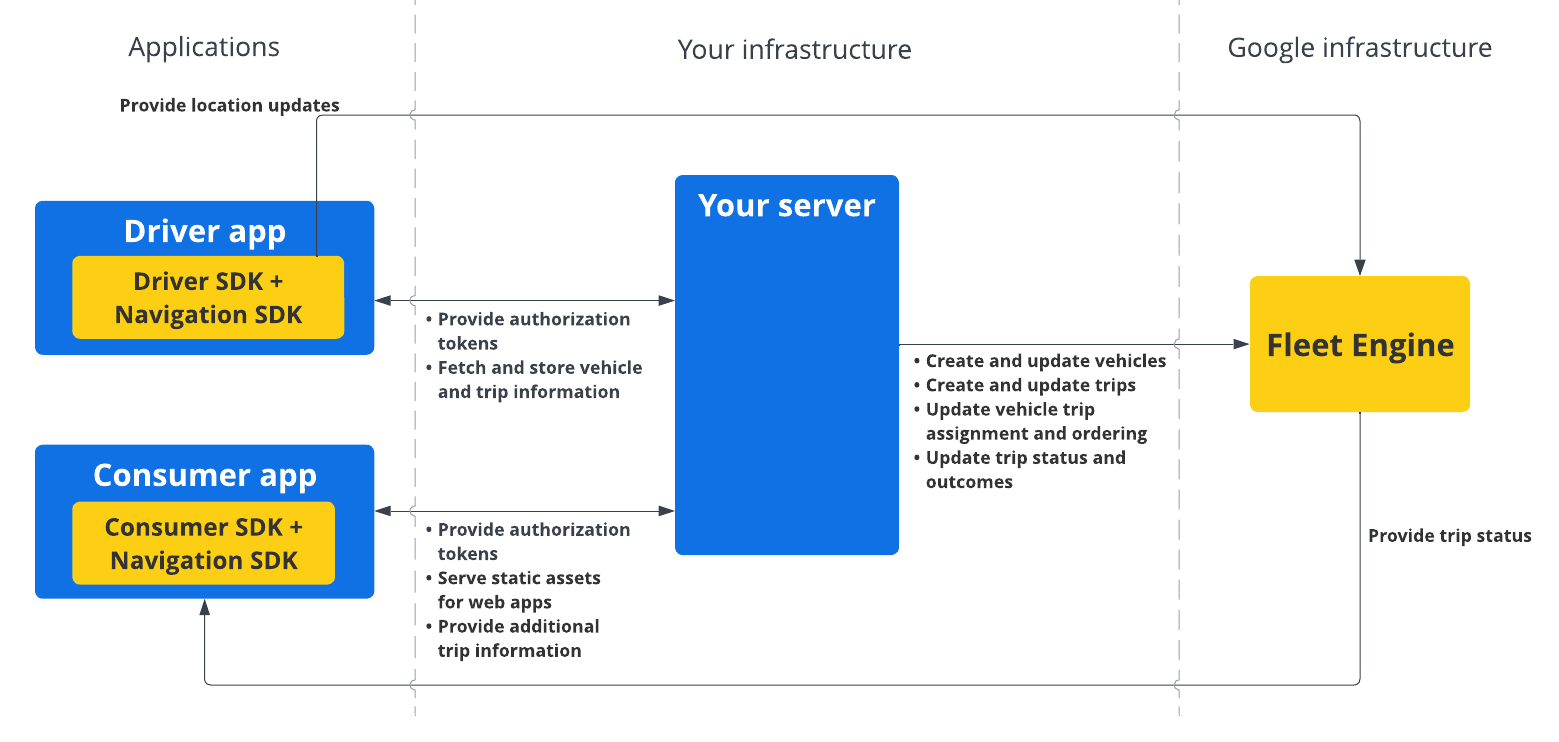Sürücü SDK'sı, mobil uygulama araç setidir ve Fleet Engine'in temel bileşenidir. Bu SDK ile sürücü uygulamanız hem atanan seyahatleri yönetebilir hem de sürücü navigasyonunu ve rota oluşturma özelliklerini etkinleştirebilir.
Başlamadan önce
Bu kılavuzda, aşağıdakileri okuduğunuz varsayılmaktadır:
- Fleet Engine ile ilgili temel bilgiler
- Araçlar için veri modeli.
- Talep üzerine geziler için veri modeli.
- Fleet Engine'i ayarlama
- Fleet Engine'de araç oluşturma ve kullanma.
Talep üzerine yolculuklar için Sürücü SDK'sı nedir?
Driver SDK'sı, Fleet Engine'in araçları ve bunlara atanmış gezileri izleyebilmesi için araç konumu ve gezi güncellemelerini Fleet Engine'e iletir. SDK, sürücünüz araç kullanmaya başladığında konum güncellemelerini ve enlem/boylam koordinatlarını, mevcut rota segmenti ve Navigation SDK'sından alınan hedefle birlikte Fleet Engine'e göndermek için temel olarak bir etkinlik dinleyici kullanır.
Talep üzerine yolculuklar için Sürücü SDK'sını neden kullanmalısınız?
Driver SDK, sürücü rotalarındaki güncellemeler için Fleet Engine ile daha kolay entegrasyon sağlar. Bu SDK sayesinde sürücünüz, görevleri yönetmek ve yol tarifi almak için tek bir uygulama kullanabilir. Bu uygulamada, Google Haritalar'ın tüketici sürümünde olduğu gibi başka bir uygulamaya geçmek zorunda kalmadan gezinebilir.
Talep üzerine yolculuklar için Sürücü SDK'sı ile yapabilecekleriniz
Aşağıdaki bilgileri Fleet Engine ile iletmek için isteğe bağlı yolculuklarda Sürücü SDK'sını kullanın:
- Bir aracın haritadaki gerçek zamanlı konumu.
- Navigation SDK tarafından sağlanan gezi ara noktalarının enlem/boylam koordinatları.
- Bir sonraki yol noktasına kalan mesafe.
- Bir sonraki ara noktaya tahmini varış zamanı.
- Navigasyon SDK'sı tarafından sağlanan, aracın gitmesi gereken rota.
Talep üzerine yolculuklar için Sürücü SDK'sının işleyiş şekli
Sürücü SDK'sı, rota bilgileri ve hedef için Navigasyon SDK'sına bağlıdır. Driver SDK, Navigation SDK'dan alınan bilgilerle birlikte sürücü uygulamanızla entegre olur ve Fleet Engine'e konum güncellemeleri, enlem/boylam koordinatları, kalan mesafe ve tahmini varış zamanları içeren bir akış sağlar. Diğer tüm araç verisi güncellemeleri, verileri Fleet Engine'e ileten müşteri arka ucuna gönderilmelidir.

Talep üzerine yolculuklar için sürücü SDK'sını kullanma
Sürücü SDK'sını kullanmaya nasıl başlayacağınızı görmek için platformunuzu seçin.
Android
| 1 | Android için Sürücü SDK'sını edinme | Daha fazla bilgi için Sürücü SDK'sını edinme başlıklı makaleyi inceleyin. |
| 2 | Google Cloud Console projesi yapılandırma | Daha fazla bilgi için Google Cloud Console projesi yapılandırma başlıklı makaleyi inceleyin. |
| 3 | Bağımlılıkları beyan etme | Daha fazla bilgi için Bağımlılıkları bildirme başlıklı makaleyi inceleyin. |
| 4 | Kimlik doğrulama jetonları oluşturma | Daha fazla bilgi için Kimlik doğrulama jetonları oluşturma başlıklı makaleyi inceleyin. |
| 5 | Sürücü SDK'sını başlatma | Daha fazla bilgi için Sürücü SDK'sını başlatma başlıklı makaleyi inceleyin. |
| 6 | Aracı hazırlama | Daha fazla bilgi için Aracı hazırlama başlıklı makaleyi inceleyin. |
| 7 | Seyahat ayrıntılarını ayarlama | Daha fazla bilgi için Seyahat ayrıntılarını ayarlama başlıklı makaleyi inceleyin. |
iOS
| 1 | iOS için Sürücü SDK'sını edinme | Daha fazla bilgi için Sürücü SDK'sını edinme başlıklı makaleyi inceleyin. |
| 2 | Google Cloud Console projesi yapılandırma | Daha fazla bilgi için Google Cloud Console projesi yapılandırma başlıklı makaleyi inceleyin. |
| 3 | Kimlik doğrulama jetonları oluşturma | Daha fazla bilgi için Kimlik doğrulama jetonları oluşturma başlıklı makaleyi inceleyin. |
| 4 | Sürücü SDK'sını başlatma | Daha fazla bilgi için Sürücü SDK'sını başlatma başlıklı makaleyi inceleyin. |
| 5 | Aracı hazırlama | Daha fazla bilgi için Aracı hazırlama başlıklı makaleyi inceleyin. |
| 6 | Seyahat ayrıntılarını ayarlama | Daha fazla bilgi için Seyahat ayrıntılarını ayarlama başlıklı makaleyi inceleyin. |
Sırada ne var?
Sürücü SDK'sını ayarlamak istediğiniz platformun belgelerine bakın:

